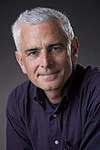From quantum to cosmos
 |
|
Craig Hogan
|
Craig Hogan, head of the Center for Particle Astrophysics, wrote this column.
On Monday morning, cosmologists around the world felt a wave of ecstasy as they learned of a breathtaking discovery: a particular pattern of light coming from the early universe, imprinted on the cosmic expansion during its first moments. It feels like a love letter from Mother Nature has invited us to share her deepest secrets.
All forms of matter and energy come in quanta — the "particles" of particle physics. For the first time, we have now detected a quantum behavior of space and time. The new result invokes an interplay among all the scales of physical universe, from the smallest to largest, from the beginning to the present day. It spectacularly confirms many of the "inner space/outer space" connections pioneered over several decades by Fermilab's astrophysics theory group. This includes the amazing idea that quantum fluctuations can be amplified to enormous size by cosmic expansion and lead not only to gravitational waves, but ultimately to the formation of all cosmic structures, including galaxies, stars, planets and life.
The now discovered polarization of cosmic background light displays a faint but distinctive pattern of swirls that can be created only by an extraordinarily exotic process known as inflation, a stretching of space-time (gravitational waves), caused by its own subatomic, quantum fluctuations. This unique signature reaches us intact across all the vast stretches of space since the beginning of time and can now be studied in precise detail.
The discovery, published in this paper, came sooner than anyone expected. Theorists, including Fermilab's Albert Stebbins, proposed long ago the possibility of isolating the distinctive swirling signature used to make the discovery, but everyone was surprised this week that the signal in the real universe is so strong. The implications for cosmology are immediate and profound. We now know far more reliably what conditions were during the cosmic inflation that created our expansion; for example, the new data directly measures how fast things were expanding back then. We can now delve much more concretely into the new physics that governs cosmic origins and how it connects to the unification of the Standard Model particles and forces studied at the Tevatron and the LHC. Cosmic polarization experiments may even provide real data addressing the quantum system underlying unification of the Standard Model with gravity — the "theory of everything."
The discovery was inspired by theory but propelled in recent years by new transformational technology, in particular, a new generation of sensors being developed at Argonne, Berkeley, Jet Propulsion Laboratory and NIST. Large focal plane arrays of antennas are fabricated on silicon wafers, together with superconducting detectors that achieve quantum-noise-limited performance. In experiments, they are deployed in advanced telescopes at the world's best site for peering deep into space, the South Pole.
The newly discovered effect is strong enough to confirm soon with other experiments, perhaps even using data already obtained. The next step will be to improve the quality of the measurements with a larger area of sky, more frequency bands and higher angular resolution. That will require larger focal planes with more detection elements and a larger telescope.
We are already developing this next-generation experiment. It will use the world's leading facility for cosmic background studies, the South Pole Telescope (SPT). As part of a new joint effort with Argonne, the University of Chicago and other partners, Fermilab is playing a central role in developing and building the new SPT-3G cryogenic camera system, an order of magnitude more capable than that currently deployed. Over the next two years, the system will be assembled, integrated and tested at Fermilab by a team led by Brad Benson, using many of the facilities previously developed for the Dark Energy Camera and the QUIET polarization experiment, before being shipped to the South Pole.
Plans are also under way for an even more ambitious fourth-generation cosmic microwave background polarization experiment, by a larger consortium of national labs and universities. A recent APS Community Summer Study ("Snowmass") report, co-led by Fermilab's Scott Dodelson, identified such an experiment, in synergy with other surveys, as a unique opportunity to study many aspects of new physics, including neutrino masses, new relativistic species (so-called dark radiation) and dark energy. A study group proposes to expand CMB polarization capabilities by another order of magnitude beyond SPT-3G, including the addition of more telescopes to access more of the sky not visible from the South Pole. The new discovery extends and enriches the science reach of this enterprise to a new and deeper level — one we had hardly dared to dream about until this week.
|